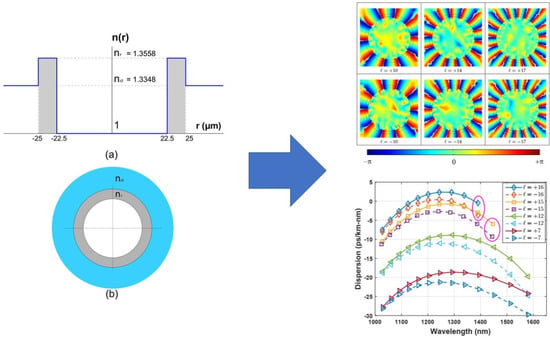Vortex Polymer Optical Fiber with 64 Stable OAM States
Abstract
1. Introduction
2. Theory
2.1. OAM Modes in Optical Fibers
2.2. Modal Coupling in Multimode Optical Fibers
2.2.1. Effective Index Separation
2.2.2. OAM Charge Weight
2.3. Fibers for OAM Propagation
3. Vortex-POF
4. Results
4.1. OAM Modes in the Vortex-POF
4.2. Dependence of the Effective Index Difference with the Wavelength of Light
4.3. Propagation Loss
4.4. Dependence of the Effective Index Difference with the Ellipticity
4.5. OAM Spectra
5. Conclusions
Author Contributions
Funding
Conflicts of Interest
References
- Huang, H.; Milione, G.; Lavery, M.P.J.; Xie, G.; Ren, Y.; Cao, Y.; Ahmed, N.; Nguyen, T.A.; Nolan, D.A.; Li, M.J.; et al. Mode division multiplexing using an orbital angular momentum mode sorter and MIMO-DSP over a graded-index few-mode optical fibre. Sci. Rep. 2015, 5, 14931. [Google Scholar] [CrossRef]
- Bozinovic, N.; Yue, Y.; Ren, Y.; Tur, M.; Kristensen, P.; Huang, H.; Willner, A.E.; Ramachandran, S. Terabit-Scale Orbital Angular Momentum Mode Division Multiplexing in Fibers. Science 2013, 340, 1545–1548. [Google Scholar] [CrossRef]
- Makino, K.; Akimoto, Y.; Koike, K.; Kondo, A.; Inoue, A.; Koike, Y. Low Loss and High Bandwidth Polystyrene-Based Graded Index Polymer Optical Fiber. J. Lightwave Technol. 2013, 31, 2407–2412. [Google Scholar] [CrossRef]
- van den Boom, H.P.A.; Li, W.; van Bennekom, P.K.; Monroy, I.T.; Khoe, G.D. High-capacity transmission over polymer optical fiber. IEEE J. Sel. Top. Quantum Electron. 2001, 7, 461–470. [Google Scholar] [CrossRef]
- Koike, Y.; Asai, M. The future of plastic optical fiber. NPG Asia Mater. 2009, 1, 22–28. [Google Scholar] [CrossRef]
- Ishigure, T.; Ohdoko, K.; Ishiyama, Y.; Koike, Y. Mode-coupling control and new index profile of GI POF for restricted-launch condition in very-short-reach networks. J. Lightwave Technol. 2005, 23, 4155–4168. [Google Scholar] [CrossRef]
- Kuzyk, M.G.; Canfield, B.K.; Garvey, D.W.; Tostenrude, J.A.; Vigil, S.R.; Young, J.E.; Zhou, Z.; Dirk, C.W. Polymer fibers as optical device components. In Optoelectronic Integrated Circuits; Park, Y.S., Ramaswamy, R.V., Eds.; SPIE: Warsaw, Poland, 1997. [Google Scholar] [CrossRef]
- Chagulov, V.S. Polymer fiber waveguides. Sov. J. Quantum Electron. 1982, 12, 1587–1592. [Google Scholar] [CrossRef]
- Fini, J.M.; Borel, P.I.; Weimann, P.A.; Kristensen, P.; Bjerregaard, J.; Carlson, K.; Yan, M.F.; Wisk, P.W.; Ramachandran, S.; Yablon, A.D.; et al. Bend Insensitive Fiber for FTTX Applications. In Optical Fiber Communication Conference and National Fiber Optic Engineers Conference; Optical Society of America: Washington, DC, USA, 2009. [Google Scholar] [CrossRef]
- Koike, Y.; Ishigure, T.; Nihei, E. High-bandwidth graded-index polymer optical fiber. J. Lightwave Technol. 1995, 13, 1475–1489. [Google Scholar] [CrossRef]
- Li, M.J.; Tandon, P.; Bookbinder, D.C.; Bickham, S.R.; Wilbert, K.A.; Abbott, J.S.; Nolan, D.A. Designs of Bend-Insensitive Multimode fibers. In Optical Fiber Communication Conference/National Fiber Optic Engineers Conference; Optical Society of America: Washington, DC, USA, 2011. [Google Scholar] [CrossRef]
- Ramachandran, S.; Kristensen, P.; Yan, M.F. Generation and propagation of radially polarized beams in optical fibers. Opt. Lett. 2009, 34, 2525. [Google Scholar] [CrossRef]
- Ramachandran, S.; Bozinovic, N.; Gregg, P.; Golowich, S.; Kristensen, P. Optical vortices in fibres: A new degree of freedom for mode multiplexing. European Conference and Exhibition on Optical Communication. Opt. Soc. 2012. [Google Scholar] [CrossRef]
- Ramachandran, S.; Kristensen, P. Optical vortices in fiber. Nanophotonics 2013, 2, 455–474. [Google Scholar] [CrossRef]
- Gregg, P.; Kristensen, P.; Ramachandran, S. Conservation of orbital angular momentum in air-core optical fibers. Optica 2015, 2, 267. [Google Scholar] [CrossRef]
- Kupferman, J.; Arnon, S. OWC with vortex beams in data center networks. In Advanced Free-Space Optical Communication Techniques and Applications III; White, H.J., Moll, F., Eds.; SPIE: Warsaw, Poland, 2017. [Google Scholar] [CrossRef]
- Wang, J.; Yang, J.Y.; Fazal, I.M.; Ahmed, N.; Yan, Y.; Huang, H.; Ren, Y.; Yue, Y.; Dolinar, S.; Tur, M.; et al. Terabit free-space data transmission employing orbital angular momentum multiplexing. Nat. Photonics 2012, 6, 488–496. [Google Scholar] [CrossRef]
- Yan, Y.; Xie, G.; Lavery, M.P.J.; Huang, H.; Ahmed, N.; Bao, C.; Ren, Y.; Cao, Y.; Li, L.; Zhao, Z.; et al. High-capacity millimetre-wave communications with orbital angular momentum multiplexing. Nat. Commun. 2014, 5, 4876. [Google Scholar] [CrossRef] [PubMed]
- Gibson, G.; Courtial, J.; Padgett, M.J.; Vasnetsov, M.; Pas’ko, V.; Barnett, S.M.; Franke-Arnold, S. Free-space information transfer using light beams carrying orbital angular momentum. Opt. Express 2004, 12, 5448. [Google Scholar] [CrossRef] [PubMed]
- Su, T.; Scott, R.P.; Djordjevic, S.S.; Fontaine, N.K.; Geisler, D.J.; Cai, X.; Yoo, S.J.B. Demonstration of free space coherent optical communication using integrated silicon photonic orbital angular momentum devices. Opt. Express 2012, 20, 9396. [Google Scholar] [CrossRef] [PubMed]
- Bozinovic, N.; Golowich, S.; Kristensen, P.; Ramachandran, S. Control of orbital angular momentum of light with optical fibers. Opt. Lett. 2012, 37, 2451. [Google Scholar] [CrossRef]
- Yan, Y.; Zhang, L.; Wang, J.; Yang, J.Y.; Fazal, I.M.; Ahmed, N.; Willner, A.E.; Dolinar, S.J. Fiber structure to convert a Gaussian beam to higher-order optical orbital angular momentum modes. Opt. Lett. 2012, 37, 3294. [Google Scholar] [CrossRef]
- Golowich, S.; Bozinovic, N.; Kristensen, P.; Ramachandran, S. Complex mode amplitude measurement for a six-mode optical fiber. Opt. Express 2013, 21, 4931. [Google Scholar] [CrossRef]
- Golowich, S. Asymptotic theory of strong spin-orbit coupling in optical fiber. Opt. Lett. 2013, 39, 92. [Google Scholar] [CrossRef]
- Ramachandran, S.; Gregg, P.; Kristensen, P.; Golowich, S.E. On the scalability of ring fiber designs for OAM multiplexing. Opt. Express 2015, 23, 3721. [Google Scholar] [CrossRef] [PubMed]
- .Borda-Hernandez, J.A.; Hernandez-Figueroa, H.E.; Serpa-Imbett, C.M. Vortex polymer optical fiber operating at a visible wavelength of 633 nm. In Proceedings of the 2017 SBMO/IEEE MTT-S International Microwave and Optoelectronics Conference (IMOC), Aguas de Lindoia, Brazil, 27–30 August 2017. [Google Scholar] [CrossRef]
- Yuan, Y.; Kong, D.; Wang, L. A hollow ring-core polymer optical fiber for supra-high bandwidth data communication. Opt. Commun. 2019, 441, 176–184. [Google Scholar] [CrossRef]
- Chromis Fiber Optics. Datasheets of the Perfluorinated Chromis GigaPOF®: GigaPOF-50SR. Available online: http://www.pofto.com/articles/03.09.05.presskit/10.Chromis.GigaPOF5.pdf (accessed on 12 November 2020).
- Snyder, A.W.; Love, J. Optical Waveguide Theory; Chapman & Hall: New York, NY, USA, 1983. [Google Scholar]
- Marcuse, D. Theory of Dielectric Optical Waveguides; Quantum electronics–principles and applications; Academic Press Inc.: New York, NY, USA, 1974. [Google Scholar]
- Huang, W.P. Coupled-mode theory for optical waveguides: An overview. J. Opt. Soc. Am. A 1994, 11, 963. [Google Scholar] [CrossRef]
- Olshansky, R. Mode Coupling Effects in Graded-Index Optical Fibers. Appl. Opt. 1975, 14, 935. [Google Scholar] [CrossRef] [PubMed]
- Yan, Y.; Wang, J.; Zhang, L.; Yang, J.Y.; Fazal, I.M.; Ahmed, N.; Shamee, B.; Willner, A.E.; Birnbaum, K.; Dolinar, S. Fiber coupler for generating orbital angular momentum modes. Opt. Lett. 2011, 36, 4269. [Google Scholar] [CrossRef]
- Han, Z.; Zhang, P.; Bozhevolnyi, S.I. Calculation of bending losses for highly confined modes of optical waveguides with transformation optics. Opt. Lett. 2013, 38, 1778. [Google Scholar] [CrossRef]
- Ramachandran, S.; Golowich, S.; Yan, M.F.; Monberg, E.; Dimarcello, F.V.; Fleming, J.; Ghalmi, S.; Wisk, P. Lifting polarization degeneracy of modes by fiber design: A platform for polarization-insensitive microbend fiber gratings. Opt. Lett. 2005, 30, 2864. [Google Scholar] [CrossRef]
- Yue, Y.; Zhang, L.; Yan, Y.; Ahmed, N.; Yang, J.Y.; Huang, H.; Ren, Y.; Dolinar, S.; Tur, M.; Willner, A.E. Octave-spanning supercontinuum generation of vortices in an As_2S_3 ring photonic crystal fiber. Opt. Lett. 2012, 37, 1889. [Google Scholar] [CrossRef]
- Bozinovic, N. Orbital Angular Momentum in Optical Fibers. Ph.D. Thesis, Boston University, Boston, MA, USA, 2013. [Google Scholar]
- Li, S.; Wang, J. Multi-Orbital-Angular-Momentum Multi-Ring Fiber for High-Density Space-Division Multiplexing. IEEE Photonics J. 2013, 5, 7101007. [Google Scholar] [CrossRef]
- Brunet, C.; Vaity, P.; Messaddeq, Y.; LaRochelle, S.; Rusch, L.A. Design, fabrication and validation of an OAM fiber supporting 36 states. Opt. Express 2014, 22, 26117. [Google Scholar] [CrossRef]
- Li, S.; Wang, J. Supermode fiber for orbital angular momentum (OAM) transmission. Opt. Express 2015, 23, 18736. [Google Scholar] [CrossRef] [PubMed]
- Asahi Glass Co. CYTOP Technical Brochure; Asahi Glass Co.: Tokyo, Japan, 2009. [Google Scholar]
- Lethien, C.; Loyez, C.; Vilcot, J.P.; Rolland, N.; Rolland, P.A. Exploit the Bandwidth Capacities of the Perfluorinated Graded Index Polymer Optical Fiber for Multi-Services Distribution. Polymers 2011, 3, 1006–1028. [Google Scholar] [CrossRef]
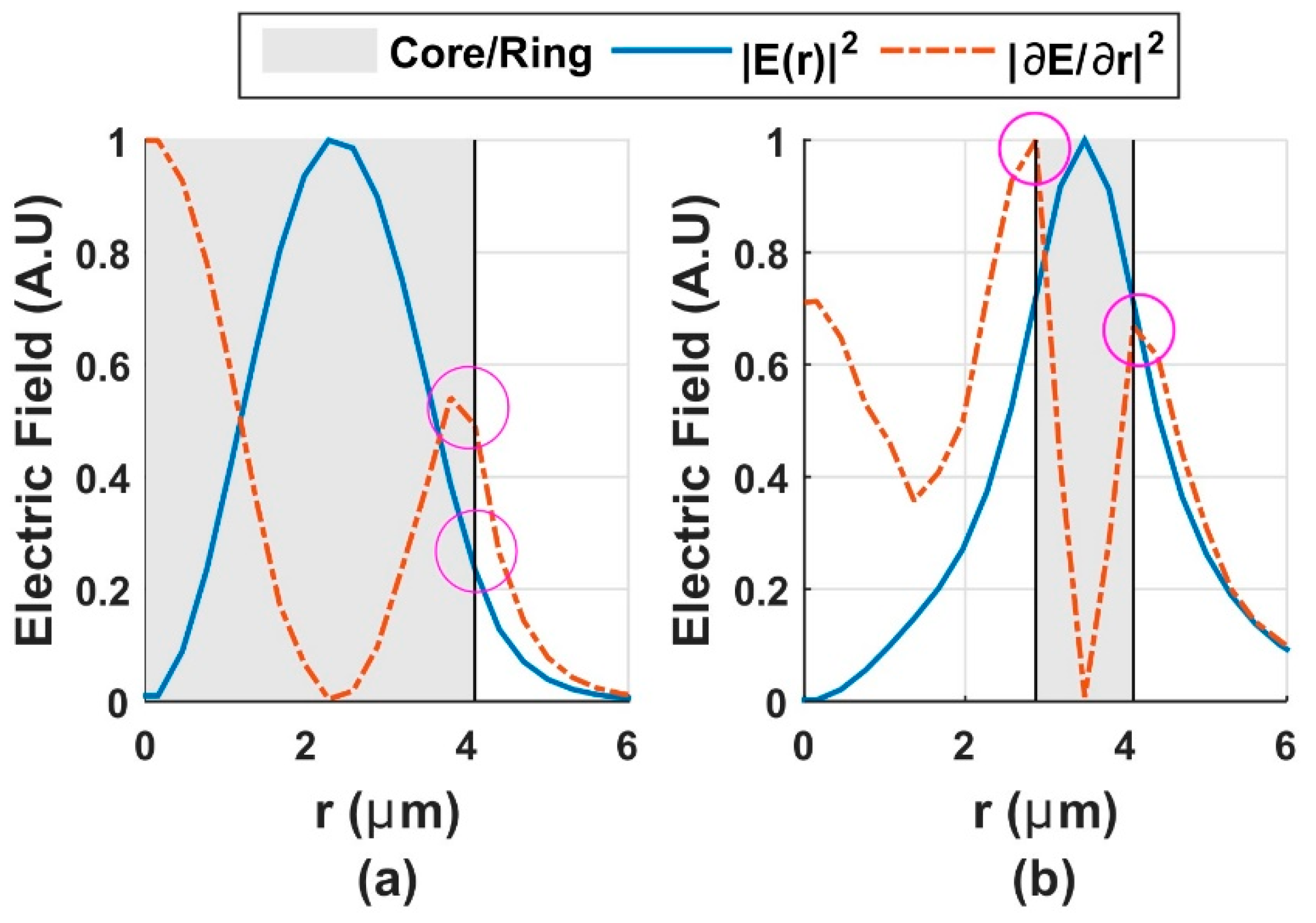
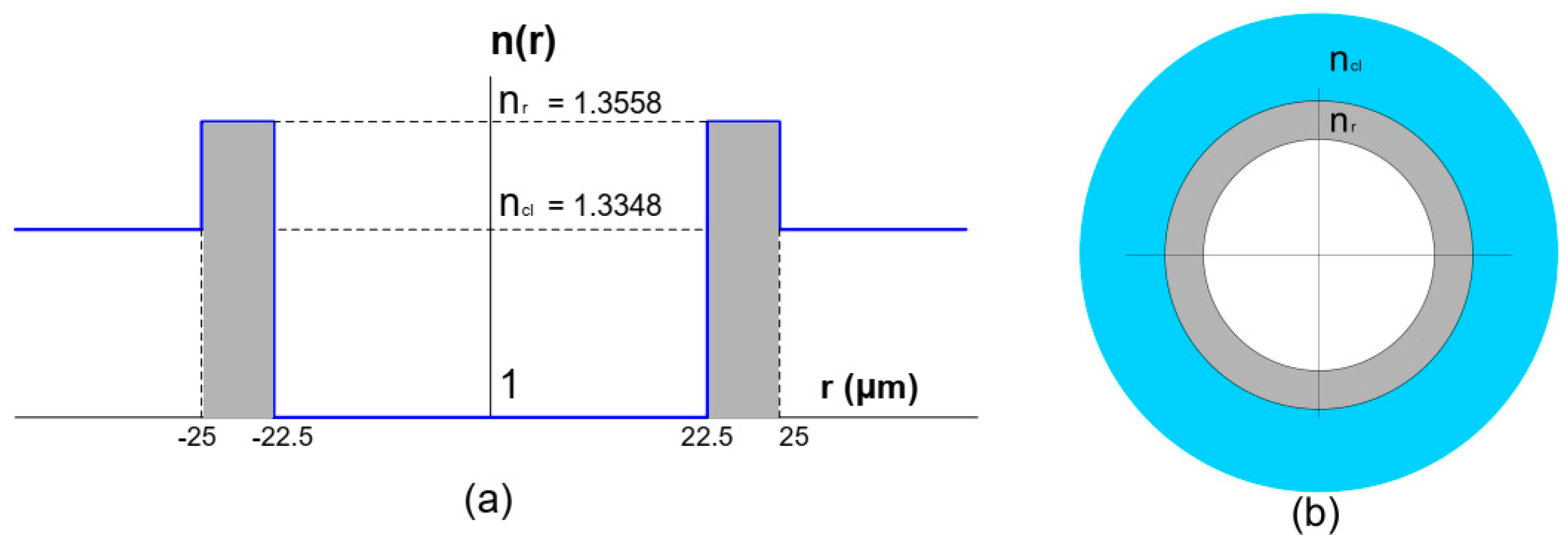
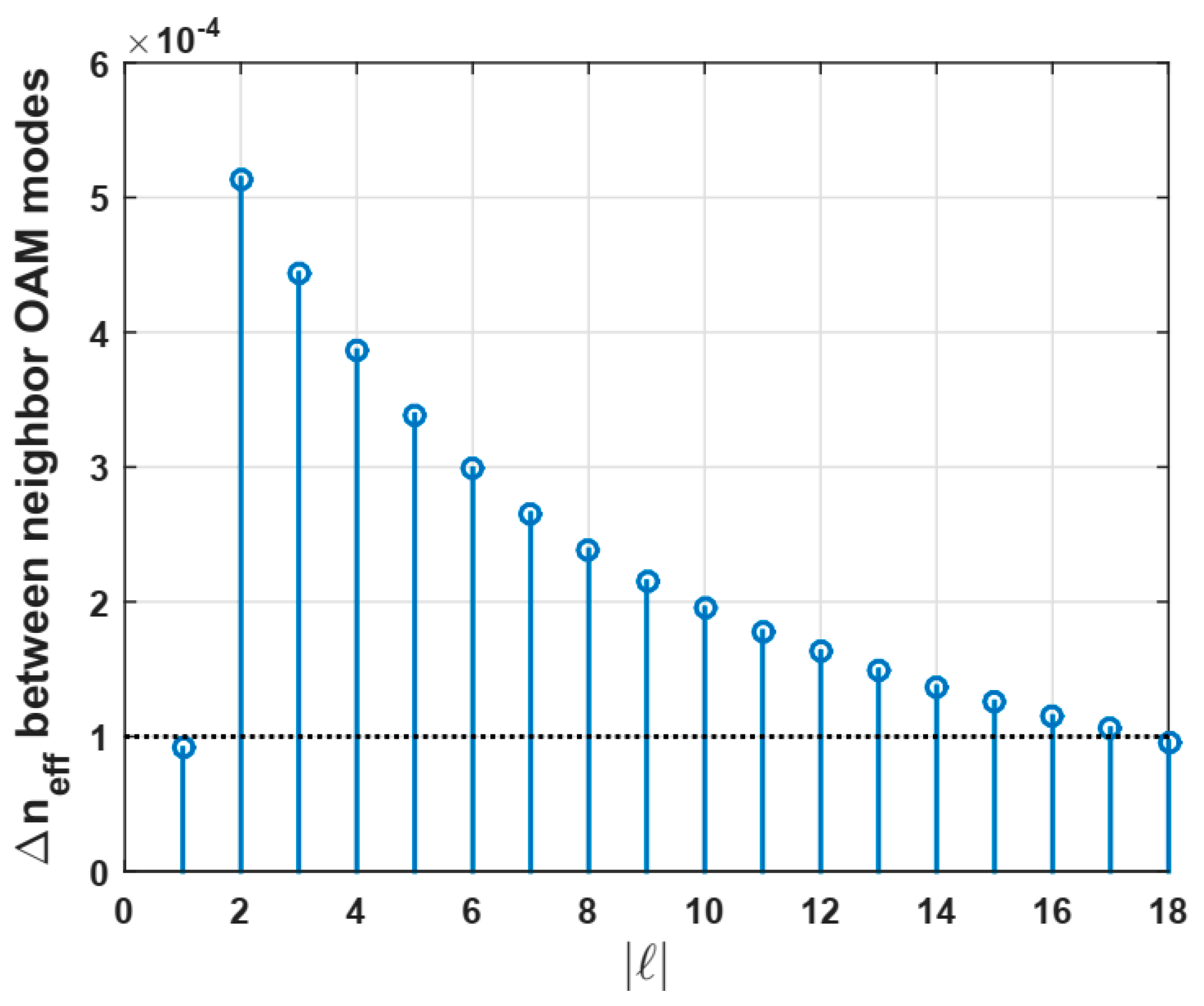
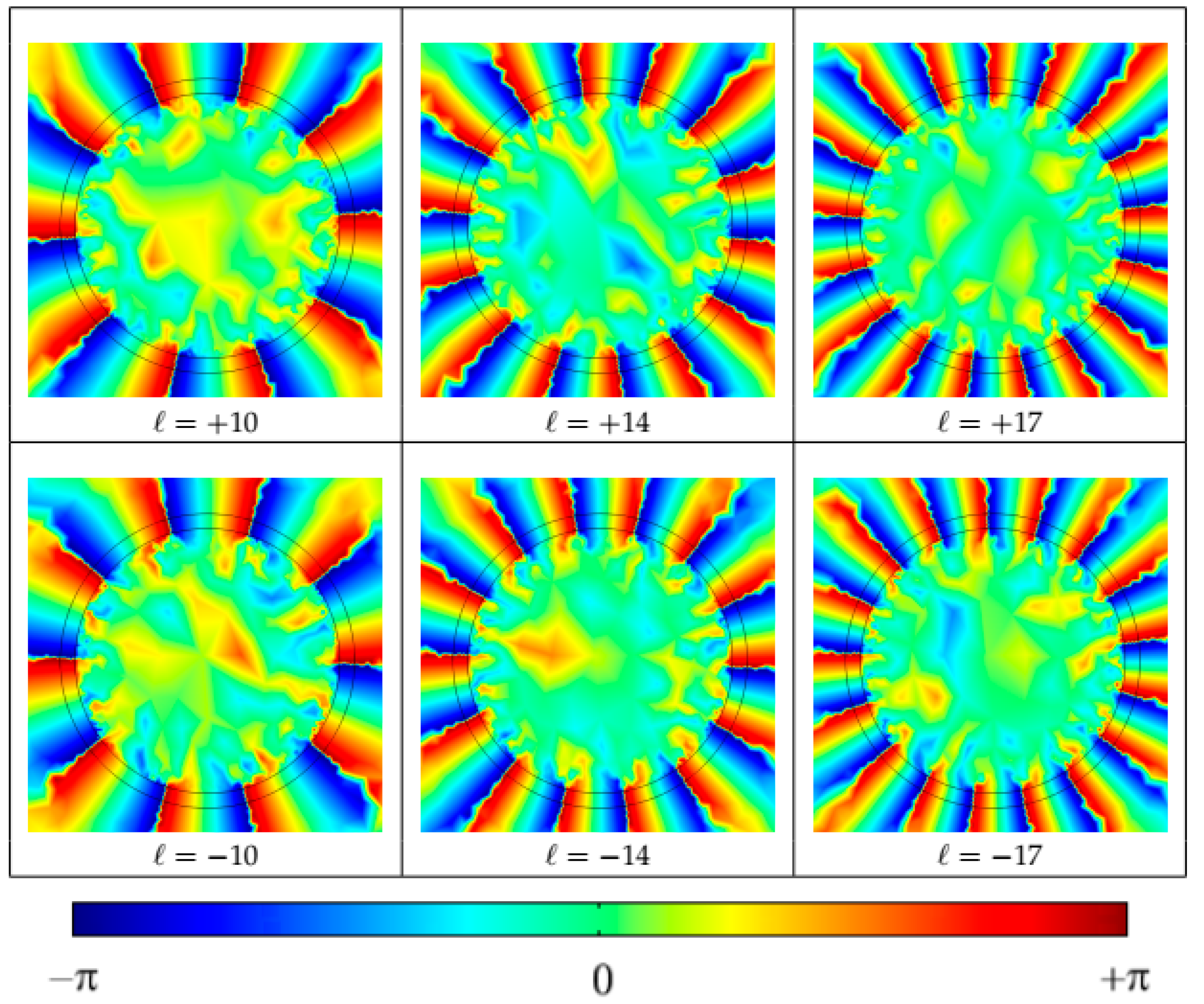
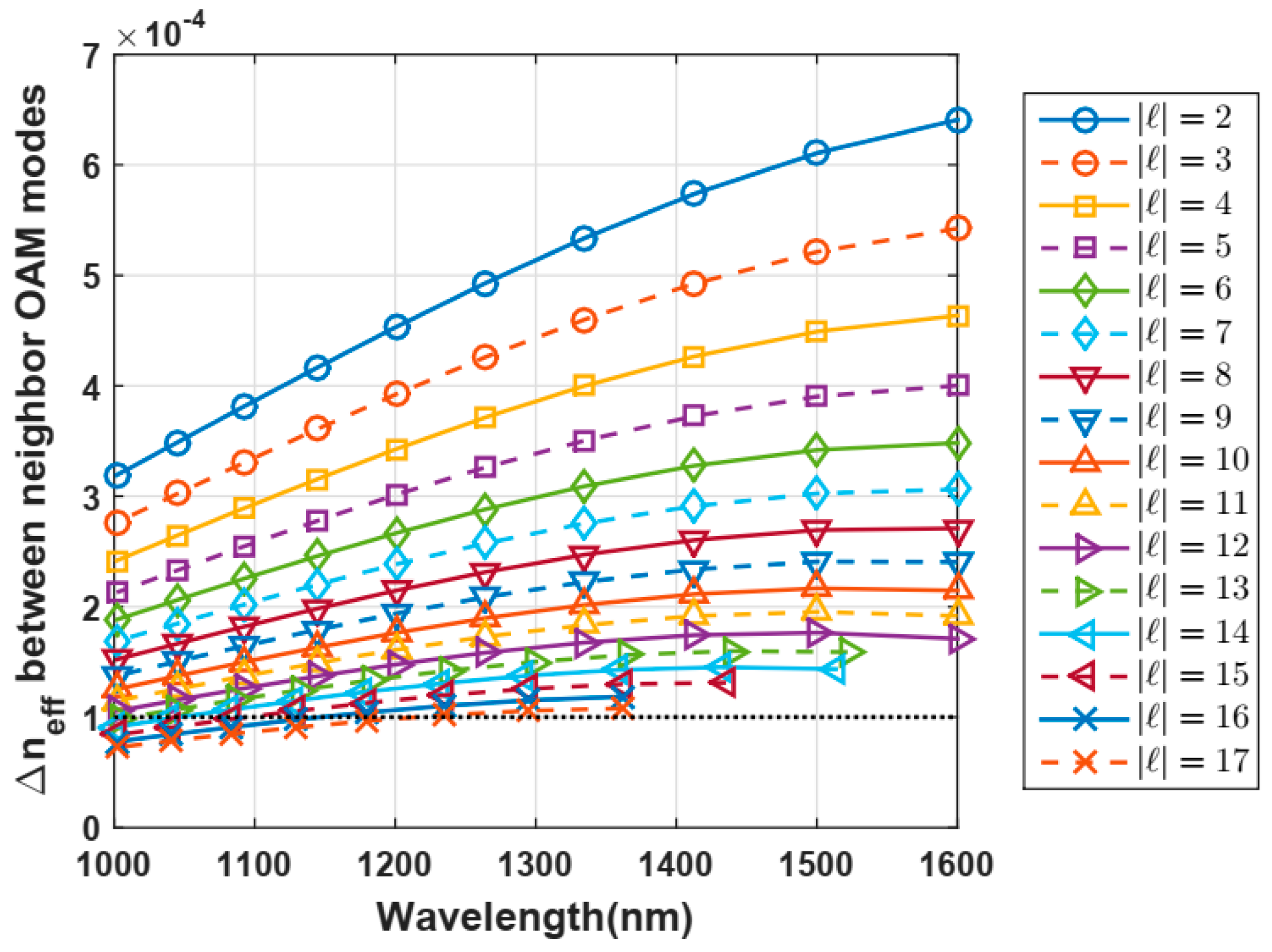
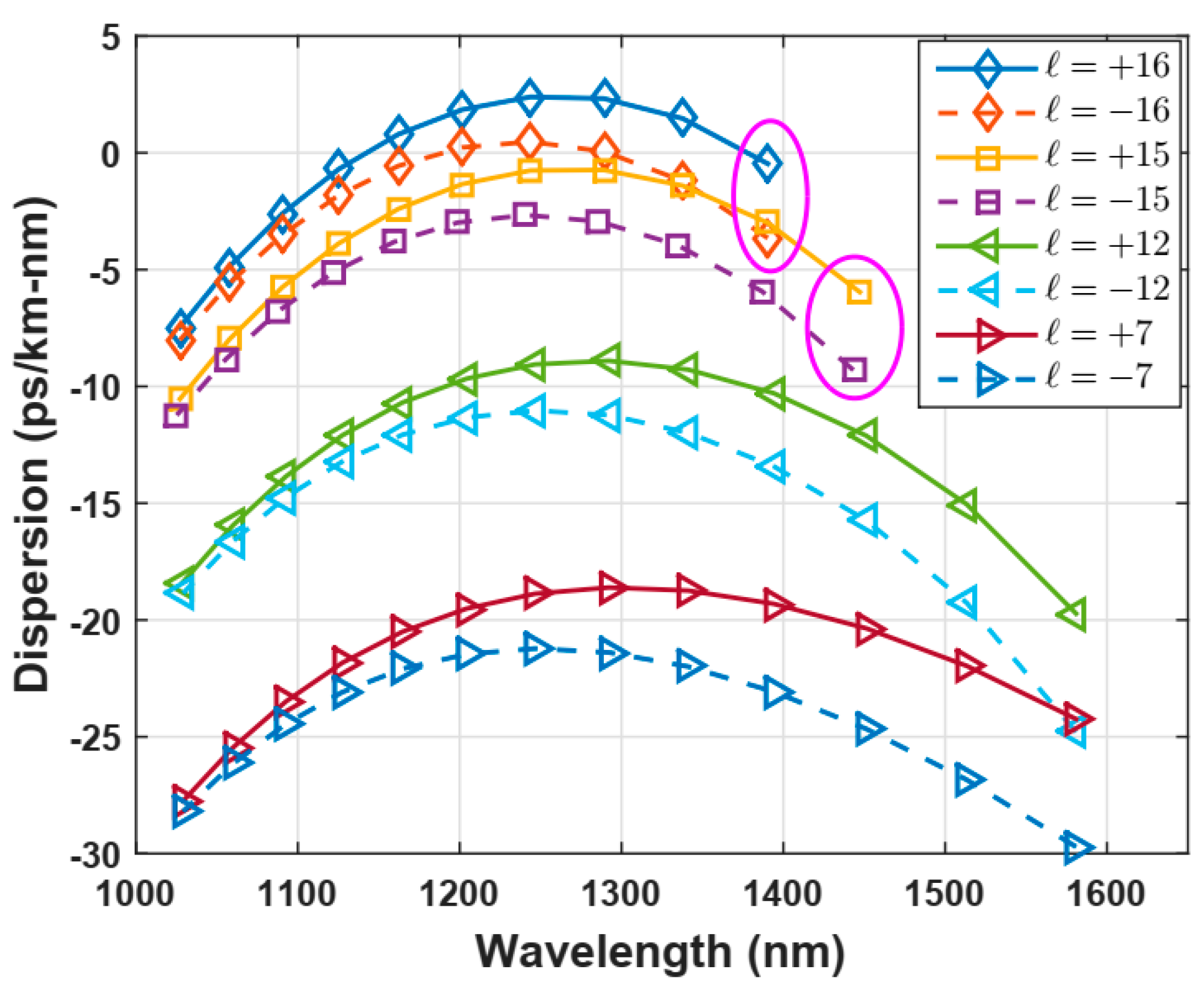
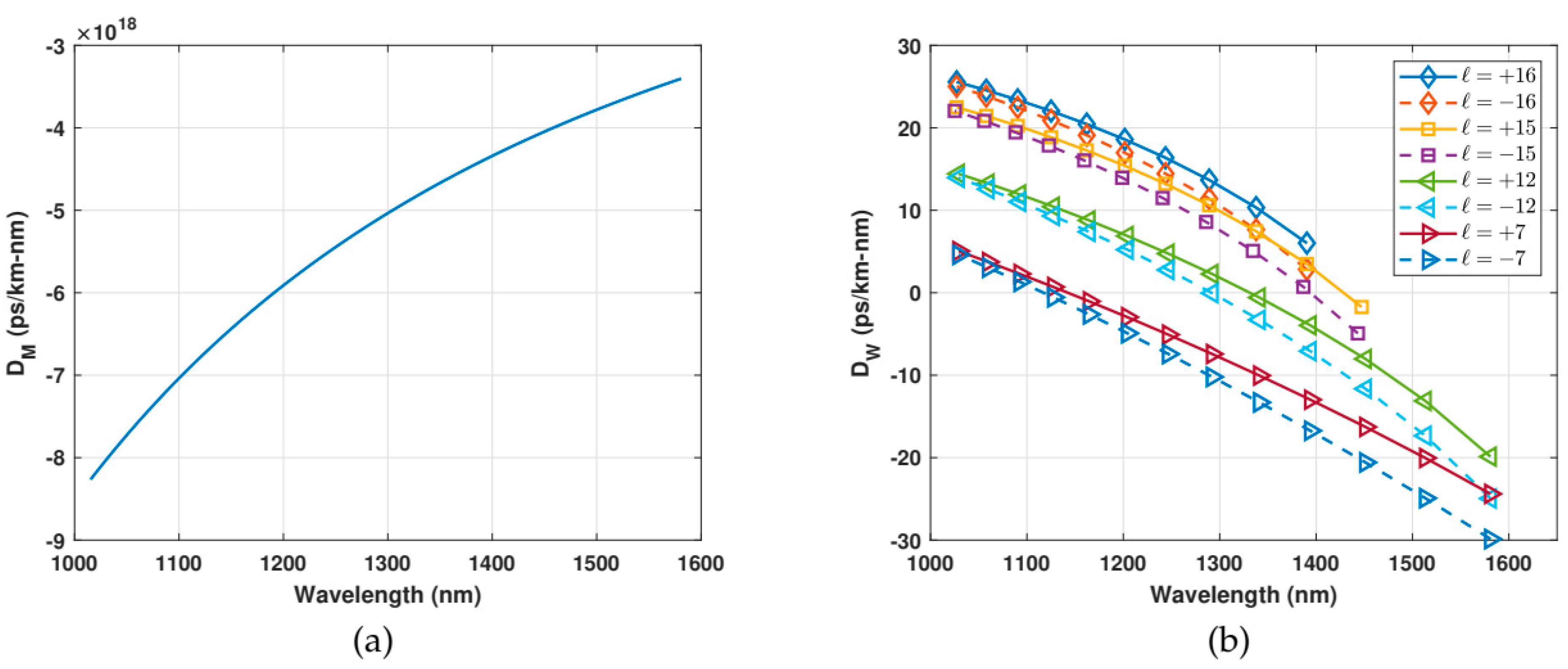

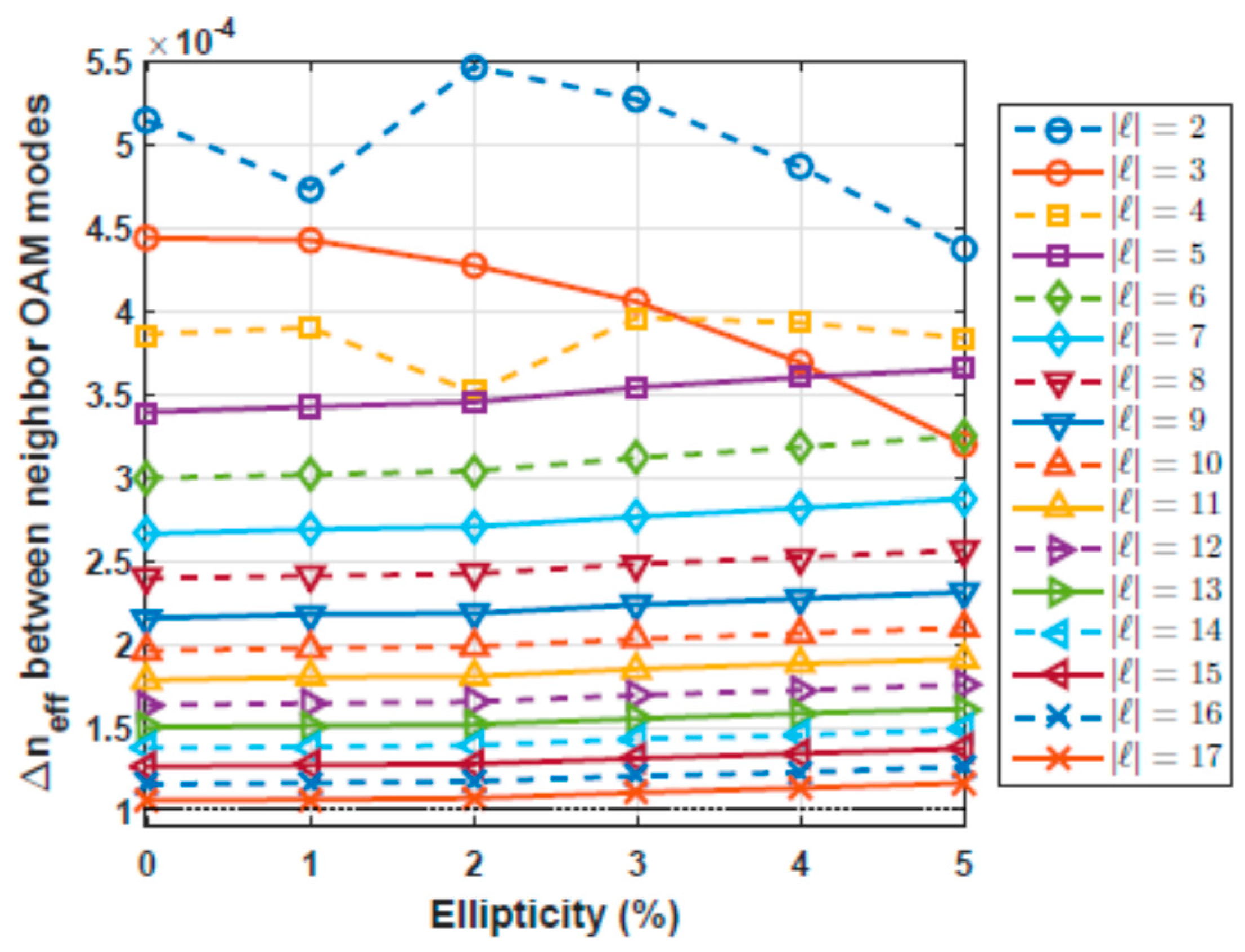
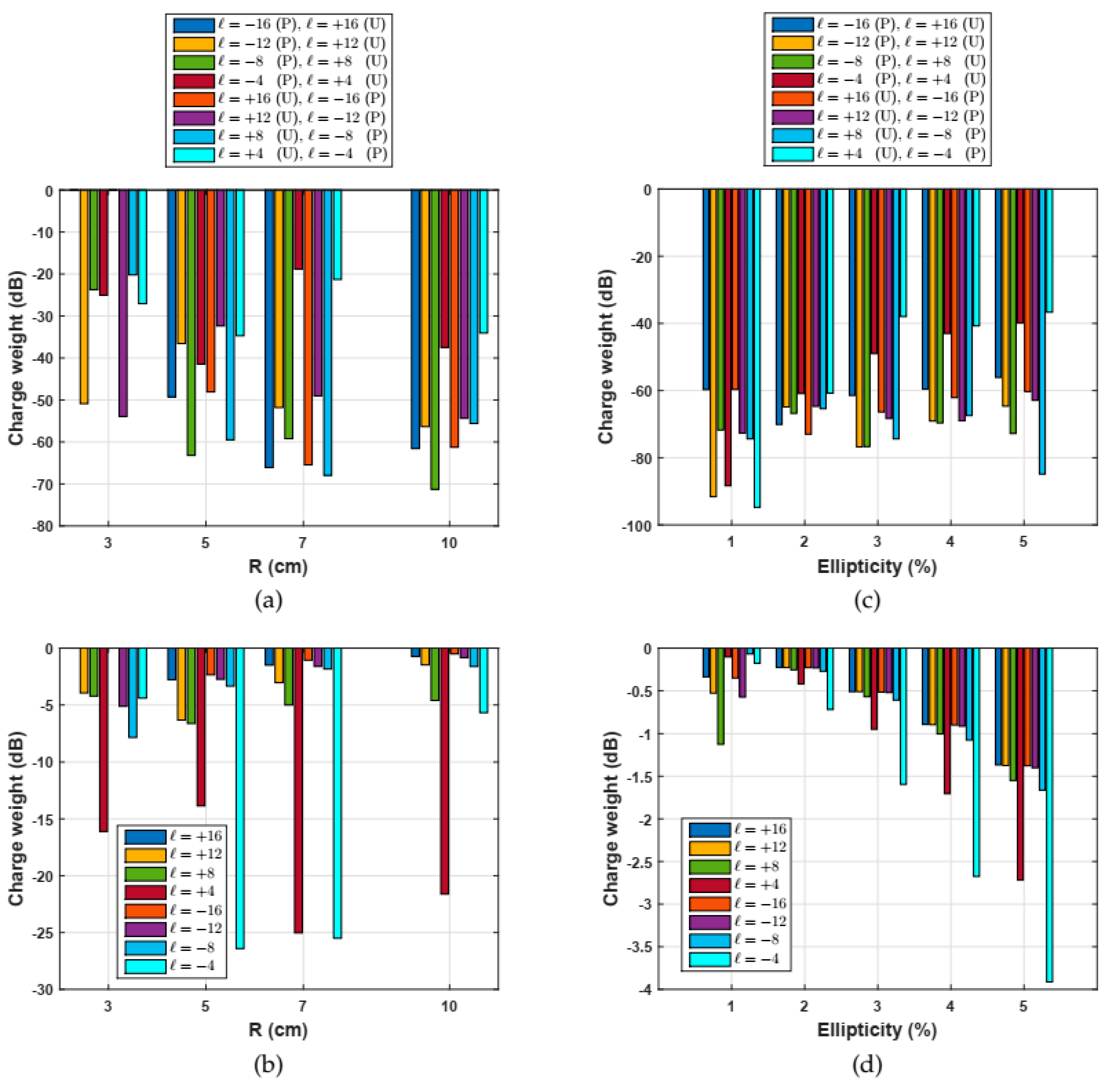
Publisher’s Note: MDPI stays neutral with regard to jurisdictional claims in published maps and institutional affiliations. |
© 2020 by the authors. Licensee MDPI, Basel, Switzerland. This article is an open access article distributed under the terms and conditions of the Creative Commons Attribution (CC BY) license (http://creativecommons.org/licenses/by/4.0/).
Share and Cite
Borda-Hernández, J.A.; Serpa-Imbett, C.M.; Figueroa, H.E.H. Vortex Polymer Optical Fiber with 64 Stable OAM States. Polymers 2020, 12, 2776. https://doi.org/10.3390/polym12122776
Borda-Hernández JA, Serpa-Imbett CM, Figueroa HEH. Vortex Polymer Optical Fiber with 64 Stable OAM States. Polymers. 2020; 12(12):2776. https://doi.org/10.3390/polym12122776
Chicago/Turabian StyleBorda-Hernández, José A., Claudia M. Serpa-Imbett, and Hugo E. Hernandez Figueroa. 2020. "Vortex Polymer Optical Fiber with 64 Stable OAM States" Polymers 12, no. 12: 2776. https://doi.org/10.3390/polym12122776
APA StyleBorda-Hernández, J. A., Serpa-Imbett, C. M., & Figueroa, H. E. H. (2020). Vortex Polymer Optical Fiber with 64 Stable OAM States. Polymers, 12(12), 2776. https://doi.org/10.3390/polym12122776




